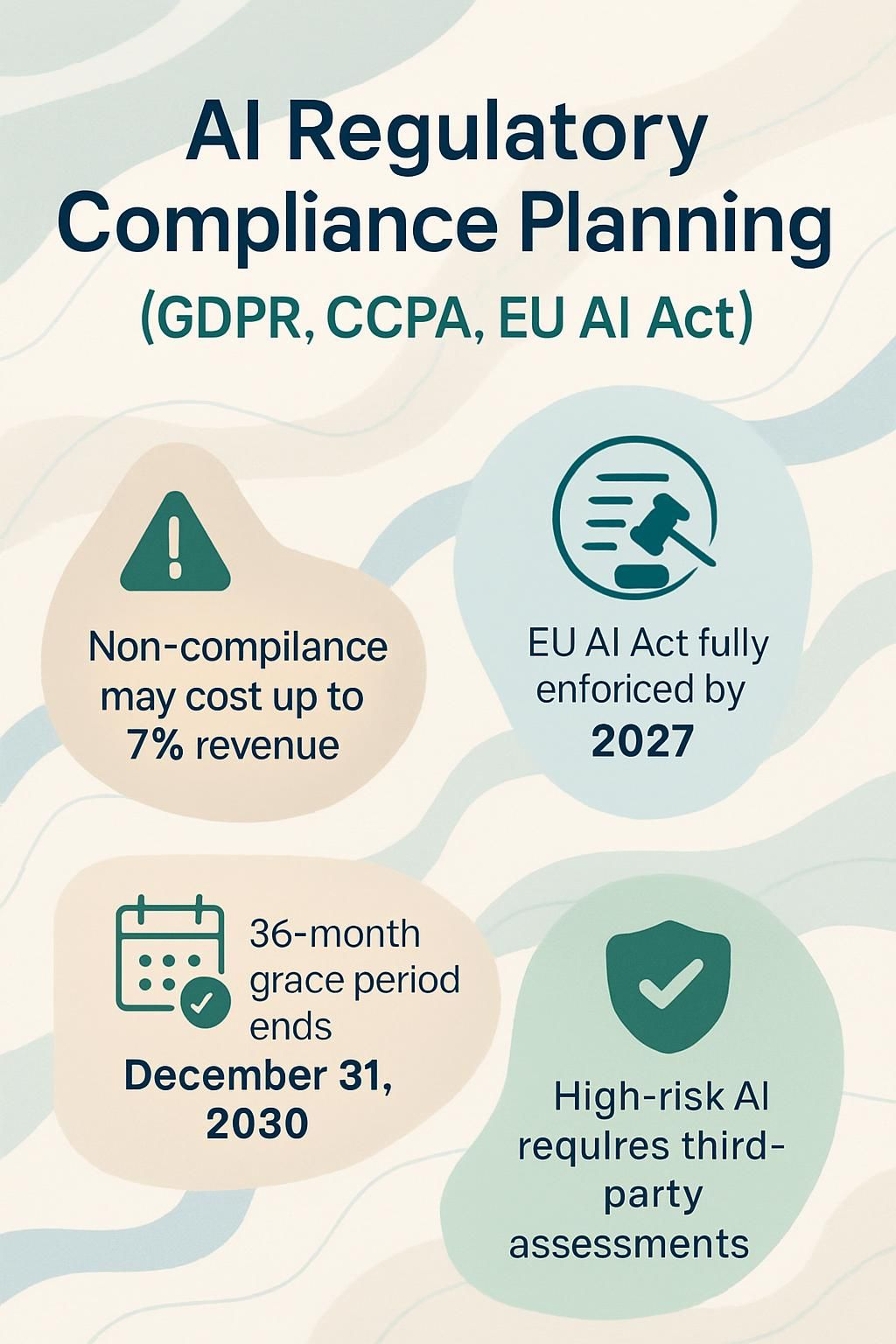AI Regulatory Compliance Planning (GDPR, CCPA, EU AI Act)


Understanding AI Integration

AI regulatory compliance refers to meeting legal requirements for artificial intelligence systems across different jurisdictions. The digital landscape now features three major regulatory frameworks: GDPR (enforced since May 2018), CCPA, and the upcoming EU AI Act (set for 2027).
These regulations create specific obligations for businesses using AI technology. The EU AI Act will apply to all AI providers and users within the EU, with hefty penalties reaching up to 7% of annual worldwide turnover or €40 million for violations.
Only 5% of countries currently have comprehensive AI regulations, making the EU's approach likely to set global standards. Companies must implement data governance frameworks, maintain transparency in AI systems, and follow privacy-by-design principles to stay compliant.
High-risk AI applications face stricter requirements, including risk management systems, documentation, human oversight, and incident reporting. The EU AI Act also bans certain AI practices outright, such as unauthorized facial image scraping and emotion inference in specific contexts.
Poor data governance increases compliance risks under both GDPR and the EU AI Act. Smart business leaders are already preparing their systems. You need a plan.
Key Takeaways
- Non-compliance with AI regulations like the EU AI Act can cost businesses up to 7% of their global annual revenue, making proper planning essential.
- GDPR took effect in May 2018, while the EU AI Act won't be fully enforced until 2027, giving companies time to prepare for the newest regulations.
- High-risk AI systems require third-party assessments and detailed documentation, including an EU declaration of conformity before deployment.
- Only 5% of countries currently have comprehensive AI laws, but the EU's approach will likely influence global standards similar to how GDPR shaped privacy rules.
- AI systems on the market 36 months before the EU AI Act's enforcement must comply by December 31, 2030, so businesses should start planning now.
Compliance Checklist:
- Review regulatory guidelines and applicable legal regulations.
- Map AI systems and data flows precisely.
- Establish risk assessment and documentation protocols.
- Implement privacy-by-design principles and data encryption.
- Plan regular security audits and compliance reviews.

Understanding AI Regulatory Compliance

AI regulations like GDPR, CCPA, and the EU AI Act create a maze of rules that businesses must follow. These laws impact how you collect data, train AI models, and make automated decisions about customers.
Regulatory Compliance Checklist:
- Identify all relevant legal regulations and privacy policies.
- Ensure robust data protection and consumer rights measures.
- Establish clear documentation for AI decision-making processes.
- Confirm adherence to Data Protection and Privacy Regulations.
AI compliance isn't just paperwork—it's about building trust with your users while avoiding hefty fines. The global patchwork of AI laws requires companies to rethink how their algorithms work and what data they process.
Overview of GDPR, CCPA, and EU AI Act
The regulatory landscape for AI has evolved rapidly with three major frameworks now shaping how businesses handle data and deploy AI systems. GDPR, which took effect in May 2018, established strict rules requiring explicit opt-in consent before processing personal data of EU citizens.
CCPA followed with similar but distinct requirements, giving California residents the right to opt out of data sales and request deletion of their information. The newest addition, the EU AI Act, introduces a risk-based approach to AI regulation with full enforcement expected by 2027.
These regulations don't just affect tech giants; they impact any business collecting data or using AI tools across borders.
Compliance isn't about checking boxes; it's about respecting digital boundaries in an age where data flows as freely as coffee at a developer meetup.
For tech-savvy business leaders, these regulations create a complex puzzle of compliance requirements. GDPR penalties can reach up to 4% of global annual revenue, making non-compliance a serious financial risk.
The CCPA focuses on transparency and consumer rights, mandating clear disclosure about data collection practices. Meanwhile, the EU AI Act categorizes AI systems based on risk levels, with stricter rules for high-risk applications like hiring algorithms or critical infrastructure.
The practical challenge lies in building systems that satisfy all applicable regulations while still delivering value. This often means redesigning data flows, implementing consent mechanisms, and documenting AI decision-making processes.
Key pain points for businesses using AI
Businesses adopting AI face significant compliance challenges that concern tech leaders. Many companies grapple with the intricacies of regulations like GDPR and the EU AI Act, where errors can result in fines up to €40 million or 7% of annual turnover.
This is a substantial amount! Documentation requirements are particularly demanding, as organizations must record AI models, decisions, and data flows in great detail. Most business owners lack specialized AI governance expertise, creating a situation ripe for confusion and risk.
The compliance responsibilities continue beyond implementation. Ongoing monitoring and regular audits consume resources and stretch teams. Many businesses report unclear returns on compliance investments, making it difficult to justify the costs to stakeholders.
Data privacy concerns add another layer of complexity, compelling companies to balance innovation against strict regulatory frameworks. For local business owners, these challenges often feel overwhelming.
The absence of standardized approaches across different regulations requires companies to manage multiple compliance frameworks concurrently.
Want To Be In The Inner AI Circle?
We deliver great actionable content in bite sized chunks to your email. No Flim Flam just great content.

Steps to Achieve Compliance
Compliance isn't a one-time checkbox but a continuous journey that demands attention at every stage of your AI implementation. You'll need clear documentation of your data practices, regular training for your team, and systems that track how AI makes decisions—all while keeping your sanity intact.
Compliance Steps:
- Create a system to document your data practices clearly.
- Conduct regular team training on Privacy Regulations and Compliance Framework requirements.
- Implement monitoring systems to track AI decision-making processes.
- Maintain updated documentation and perform regular security audits.
Establishing robust data governance frameworks
Data governance forms the backbone of AI compliance, much like a good gaming strategy needs solid rules. Your business must track data lineage and conduct bias audits to meet GDPR and EU AI Act standards.
I've seen too many companies try to wing it with makeshift spreadsheets (spoiler alert: it ends badly). Building a proper framework means creating clear policies for data collection, storage, and usage.
Think of it as setting up guardrails that keep your AI systems from veering into compliance nightmares.
AI-powered automation can supercharge your governance efforts without requiring an army of data scientists. At WorkflowGuide.com, we've found that automated monitoring tools catch data quality issues before they become regulatory headaches.
Poor governance leads directly to compliance risks and potential penalties. The trick isn't just having policies but making them work in real-world scenarios. Map your data flows, assign ownership responsibilities, and implement regular audits. Your tech stack should support transparency, not hide it behind layers of complexity.
Data Governance Checklist:
- Track data lineage and perform regular bias audits.
- Create clear policies for data collection, storage, and usage.
- Assign ownership for data management tasks.
- Conduct periodic audits to ensure transparency and accountability.
Ensuring transparency and accountability in AI systems
Transparency in AI systems isn't just a fancy buzzword, it's now a legal requirement. Tech leaders must clearly disclose when customers interact with AI-generated content, according to recent regulations.
This means your systems need built-in traceability features that document decision paths and data usage. I built an AI workflow last year that automatically generated documentation of its own processes - sounds nerdy, but the compliance team actually hugged me!
Transparency isn't just checking a regulatory box; it's building trust with your customers who deserve to know when they're talking to robots.
Accountability frameworks require specific oversight roles within your organization. The EU AI Act specifically demands that limited risk AI systems maintain clear documentation about their capabilities and limitations.
Your tech team should implement safety checkpoints where humans review AI outputs before they reach customers. User consent mechanisms must be baked into your systems from day one, not tacked on as afterthoughts.
Parliament has emphasized that AI systems must remain traceable throughout their lifecycle, which means creating governance structures that track AI from development through deployment.
Transparency Checklist:
- Implement traceability features in all AI systems.
- Clearly disclose the use of AI-generated content to users.
- Establish human oversight checkpoints at key decision points.
- Integrate consent mechanisms during system design.
- Document AI decision paths consistently.
Implementing AI Risk Management Frameworks
AI risk management isn't just fancy paperwork to please regulators. It's your business's shield against the digital dragons of compliance failures. The EU AI Act demands a structured approach where high-risk AI systems maintain ongoing risk management protocols throughout their lifecycle.
Think of it like installing guardrails on your AI highway before the speed demons of innovation cause a regulatory pile-up. Your framework should identify potential risks, evaluate their severity, and implement controls that actually work in real-world scenarios.
Building this framework requires practical steps, not theoretical mumbo-jumbo. Start by mapping your AI systems against regulatory requirements from GDPR, CCPA, and the EU AI Act. Document your data flows and AI decision points.
Create clear human oversight mechanisms for high-risk applications, because the robots shouldn't run the asylum without supervision. Many tech leaders skip the boring parts of compliance until regulators come knocking.
Don't be that person. Regular risk assessments act as your compliance compass, helping you navigate the regulatory landscape without crashing into expensive fines or reputation-damaging incidents.
Your AI governance should prioritize accountability at every level, from code to customer interaction.
Risk Management Checklist:
- Map AI systems against the latest regulatory requirements.
- Document data flows and decision points thoroughly.
- Establish human oversight for high-risk applications.
- Perform regular risk assessments and validations.
Solutions to Common Challenges
Addressing high-risk AI applications
High-risk AI systems need special attention in your compliance strategy. These systems include safety-critical components that require third-party assessments before deployment. Think of it like getting your car inspected before it hits the road, except this inspection costs more and involves AI experts in lab coats instead of mechanics with oil-stained hands.
Your team must maintain detailed system logs and prepare an EU declaration of conformity, which sounds fancy but is really just a formal "I promise this AI won't go rogue" document.
The EU AI Act specifically prohibits certain practices like biometric categorization and predictive criminal behavior assessment, so check if your cool new facial recognition tool might accidentally cross these lines.
Safety protocols for high-risk AI aren't optional extras, they're the main event. You'll need to implement rigorous testing frameworks that catch bias before it becomes a PR nightmare.
One practical approach is creating a dedicated compliance team that reviews AI applications against a standardized checklist of regulatory requirements. This team should include both technical experts who understand the AI and legal minds who can translate regulatory jargon into actual action items.
Documentation becomes your best friend here, proving you took reasonable steps to prevent harm. Implementing secure data management practices helps protect both your business and your customers from potential AI mishaps.
High-Risk AI Compliance Checklist:
- Obtain third-party assessments for high-risk AI systems.
- Maintain detailed logs and prepare an EU declaration of conformity.
- Enforce safety protocols with rigorous testing frameworks.
- Assemble a dedicated compliance team with technical and legal expertise.
Implementing secure data management practices
Secure data management forms the backbone of AI compliance. I've seen too many businesses collect mountains of data "just in case," only to create massive security headaches later.
Smart companies limit data collection to what's actually needed for processing, following the privacy-by-design playbook. This means building safeguards directly into your AI tools from day one, not bolting them on after a breach.
My clients who implement regular risk assessments catch potential privacy issues before they become regulatory nightmares.
Data security isn't just about fancy encryption (though that helps). It requires clear legal bases for all AI data processing activities. Think of your data like that garage full of stuff you might need someday, except each item comes with potential fines if mishandled.
The best approach combines technical controls with solid governance policies. Companies that master secure data practices don't just avoid penalties, they build customer trust that pays dividends. Now let's explore how implementing AI risk management frameworks can further strengthen your compliance strategy.
Data Management Checklist:
- Collect only the data necessary in line with Privacy Regulations.
- Utilize privacy-by-design principles from the start.
- Implement strong data encryption and conduct regular security audits.
- Establish clear legal bases for all AI data processing activities.
Future Outlook
AI regulations are rapidly evolving across global markets, with more countries following the EU's lead in creating comprehensive frameworks. Smart businesses are already building flexible compliance systems that can adapt to new requirements before they become mandatory.
Global trends in AI regulation look like a patchwork quilt sewn by a caffeinated octopus. Only 5% of countries currently have comprehensive AI regulations in place, creating a wild west scenario for many businesses operating across borders.
The EU AI Act stands as the sheriff in town, likely to set worldwide standards that other nations will follow or adapt. Think of it as the GDPR moment for artificial intelligence, where one region's rules ripple outward to become de facto global standards.
Companies that prepare now won't be caught scrambling later when these regulations inevitably spread to their markets.
International cooperation is gaining momentum through initiatives like the Global Cross-Border Privacy Rules Forum. This represents a shift from fragmented national approaches toward more harmonized standards.
The EU's risk-based system for classifying AI applications offers a practical framework that many countries might adopt or modify. For tech-savvy business leaders, this means planning compliance strategies that can flex with emerging global norms rather than building separate systems for each market.
The next critical step involves understanding how to implement effective AI risk management frameworks that satisfy these evolving regulations.
Preparing for evolving compliance requirements
As global AI regulations take shape, smart business leaders must look beyond today's rules. The compliance landscape won't sit still while you perfect your current systems. Forward-thinking companies are building adaptability into their compliance frameworks now.
This means creating flexible documentation processes and establishing regular review cycles that can quickly incorporate new requirements as they emerge.
Your compliance strategy needs breathing room to grow with changing laws. Mark December 31, 2030 on your calendar, as AI systems on the market 36 months before the EU AI Act's enforcement must comply by this date.
Don't wait until deadlines loom to start planning. Set up quarterly assessment meetings to review your AI governance structures. Develop modular compliance protocols that can plug into different regulatory frameworks.
Think of compliance like software development, with regular updates and patches rather than one big release. This approach transforms regulatory headaches into strategic advantages that keep your business ahead of competitors still playing catch-up with yesterday's rules.
Future Regulatory Planning:
- Monitor emerging EU Regulations and global compliance trends.
- Adjust privacy policies and data protection measures as new laws emerge.
- Implement flexible documentation processes and schedule regular review cycles.
- Plan periodic updates to risk management and compliance frameworks.
Conclusion
Staying ahead of AI regulations isn't just smart business, it's becoming mandatory survival gear. GDPR, CCPA, and the EU AI Act create a complex maze that demands your attention now, not later.
Your data governance strategy must evolve from basic compliance to proactive risk management. Smart businesses are building transparency into their AI systems from day one rather than bolting it on after problems arise.
The regulatory landscape will continue shifting as governments worldwide catch up to AI capabilities. Start your compliance journey today with clear documentation, regular audits, and staff training on privacy requirements.
Your future self (and your legal team) will thank you for the headache prevention and competitive edge that comes with responsible AI practices.
FAQs
1. What is AI regulatory compliance planning?
AI regulatory compliance planning means getting your AI systems to follow laws like GDPR, CCPA, and the EU AI Act. It's about making your tech play by the rules. Think of it as teaching your AI to stay in its lane on the digital highway.
2. Why should my company care about GDPR and CCPA for our AI systems?
These laws protect people's data rights and can hit your wallet hard if ignored. GDPR fines reach up to 4% of global revenue, while CCPA violations cost $2,500 per accident. Your reputation also takes a beating when you mess up.
3. How does the EU AI Act differ from other regulations?
The EU AI Act focuses on AI risk levels rather than just data protection. It sorts AI systems into risk categories and bans some completely. This law goes beyond privacy concerns to address how AI impacts human rights and safety.
4. What steps should I take to start compliance planning?
First, map all your AI systems and the data they use. Next, check which laws apply to each system based on where you operate. Create clear policies for AI use in your company. Last, train your team on these rules and keep records of your compliance work.
WorkflowGuide.com is a specialized AI implementation consulting firm that transforms AI‑curious organizations into AI‑confident leaders through practical, business‑first strategies. The firm provides hands‑on implementation guidance, comprehensive readiness assessments, and actionable frameworks that align AI adoption with core business objectives. Their approach emphasizes Data Privacy, EU Regulations, Data Protection, and Responsible AI Use while ensuring adherence to Privacy Regulations and ethical AI practices. This method supports strong Algorithmic Accountability, thorough Risk Assessment, and secure Data Encryption through regular Security Audits.
Disclaimer: This content is for informational purposes only and does not constitute legal or regulatory advice. Consult with qualified professionals regarding Data Privacy, EU Regulations, and Privacy Policies.
Still Confused
Let's Talk for 30 Minutes
Book a no sales only answers session with a Workflow Guide
References and Citations
References
- https://dialzara.com/blog/ccpa-vs-gdpr-ai-data-privacy-comparison/
- https://hbr.org/2024/02/the-eus-ai-act-and-how-companies-can-achieve-compliance
- https://gdprlocal.com/top-ai-compliance-strategies-you-need-to-know/ (2025-02-25)
- https://www.oceg.org/building-data-governance-for-ai/
- https://www.europarl.europa.eu/topics/en/article/20230601STO93804/eu-ai-act-first-regulation-on-artificial-intelligence (2025-02-19)
- https://papers.ssrn.com/sol3/Delivery.cfm/4961260.pdf?abstractid=4961260
- https://www.researchgate.net/publication/389799328_Risk_Management_Framework_in_the_AI_Act (2025-03-14)
- https://digital-strategy.ec.europa.eu/en/policies/regulatory-framework-ai
- https://secureprivacy.ai/blog/ai-personal-data-protection-gdpr-ccpa-compliance
- https://gdprlocal.com/ai-regulations-and-the-future-of-global-data-protection/ (2025-01-23)
- https://hyperight.com/guide-to-navigating-ai-regulations-in-2025-6-predictions-and-strategies-for-compliance/ (2025-03-14)



